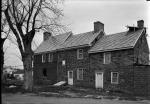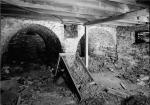![header=[Marker Text] body=[A fine example of early Pennsylvania rural architecture. Brick section was built before 1708 by Thomas Massey, who by 1696 was owner of a 300-acre "plantation" here. An earlier central wooden section was replaced by stone about 1730 by his son. Original wood kitchen replaced by stone about 1800. Room above kitchen added sixty years later. The house was deeded in 1964 to Marple Township and was restored.] sign](http://explorepahistory.com/kora/files/1/10/1-A-139-139-ExplorePAHistory-a0a5g4-a_450.gif)
Mouse over for marker text
Name:
Thomas Massey House
Region:
Philadelphia and its Countryside/Lehigh Valley
County:
Delaware
Marker Location:
467 Lawrence Rd. (SR 1020), .5 mile NE of PA 320, Haverford
Dedication Date:
May 9, 1986
Behind the Marker
In 1683, at the age of eighteen, Thomas Massey left old England for the chance at a better life in America. As a member of the Religious Society of Friends (also known as the Quakers), Massey and his fellow believers were subject to fines and imprisonment for worshipping as they pleased and not supporting the official state church - the Church of England.
Massey's prospects for property ownership were limited since very wealthy people owned most of the land. As a farmer in England he would have to rent a plot of ground and hope to eke out a living making just enough money to pay his rent. Wanting a better future, Massey joined the thousands of the "middling" and poor English, Scots, and Welsh who decided to "push fortune" and emigrate to a new North American colony established by prominent Quaker William Penn as a refuge for other Friends - Pennsylvania.
Unable to pay for his passage, Massey struck a bargain with wealthy Quaker Francis Standfield, who also was headed for Penn's colony. In return payment for his passage, Massey signed an indenture that required him to work for Standfield for a period of five to seven years. At the end of this time, Standfield, in turn, agreed to give him "freedom dues… according to the custom of the country." In these early years, freedom dues in Pennsylvania included one new suit of clothes, ten bushels of wheat or fourteen of corn, one axe, two hoes and, most importantly, land. On July 11, 1683, Massey and seven other indentured servants in the employ of the Standfield family joined twenty-three other Quaker families and embarked on the "Endeavour" out of Liverpool for far-away Pennsylvania. The ship made landfall at Upland (present-day Chester) on September 29, 1683. Just twenty-eight days after he turned nineteen, Thomas Massey embarked on a new life.
At the end of his time of service, Massey received his promised freedom dues - 100 acres of land near present-day Broomall - fifty from Francis Standfield and fifty from proprietor William Penn. Now an independent landowner, he worked quickly to clear some of his ground, build a shelter, and plant crops. In short order, he built a log home and began to farm.
In 1692, Massey married twenty-two-year-old Phebe Taylor and began to raise a family. Four years later, he was able to buy an additional two hundred acres of land from James Standfield, the son of his former master. In the same year he started to build a brick addition to his log cabin for his wife and their two young children, Ester and Mordecai. When finished, the new brick home contained a walk-in fireplace and beehive oven (a domed oven for baking, built into the side of the house).
Measured by the standards of the day, a new brick home was a substantial accomplishment that indicated Massey's success. Comfort and security, a beautiful brick house, a 300-acre plantation, and freedom of worship was more - much more - than he ever could have expected back in England.
When Thomas Massey died in 1708, he left his home and property to his eldest son Mordecai, who remodeled the house in the early 1730s and tore down the original log cabin, replacing it with a stone addition and kitchen. In 1964 a Massey descendant, Lawrence M.C. Smith, saved the home from demolition by buying it and donating it to Marple Township for preservation. Today, the restored Thomas Massey home sits on one acre of his former plantation. It is open to the public by appointment.
Thomas Massey's rise from indentured servant to an independent farmer, homeowner and landowner demonstrated the opportunities that drew more Europeans to Pennsylvania than to any of Britain's other North American colonies in the eighteenth century. His experience and the experiences of others like him, inspired tens of thousands in the eighteenth century to come to a place that many people by the 1720s were calling "the best poor man's country in the world." Farmers like Massey and his descendants, and the descendants of so many other immigrants who followed, were the foundation of Pennsylvania's economy and the backbone of its society for generations to come.
Massey's prospects for property ownership were limited since very wealthy people owned most of the land. As a farmer in England he would have to rent a plot of ground and hope to eke out a living making just enough money to pay his rent. Wanting a better future, Massey joined the thousands of the "middling" and poor English, Scots, and Welsh who decided to "push fortune" and emigrate to a new North American colony established by prominent Quaker William Penn as a refuge for other Friends - Pennsylvania.
Unable to pay for his passage, Massey struck a bargain with wealthy Quaker Francis Standfield, who also was headed for Penn's colony. In return payment for his passage, Massey signed an indenture that required him to work for Standfield for a period of five to seven years. At the end of this time, Standfield, in turn, agreed to give him "freedom dues… according to the custom of the country." In these early years, freedom dues in Pennsylvania included one new suit of clothes, ten bushels of wheat or fourteen of corn, one axe, two hoes and, most importantly, land. On July 11, 1683, Massey and seven other indentured servants in the employ of the Standfield family joined twenty-three other Quaker families and embarked on the "Endeavour" out of Liverpool for far-away Pennsylvania. The ship made landfall at Upland (present-day Chester) on September 29, 1683. Just twenty-eight days after he turned nineteen, Thomas Massey embarked on a new life.
At the end of his time of service, Massey received his promised freedom dues - 100 acres of land near present-day Broomall - fifty from Francis Standfield and fifty from proprietor William Penn. Now an independent landowner, he worked quickly to clear some of his ground, build a shelter, and plant crops. In short order, he built a log home and began to farm.
In 1692, Massey married twenty-two-year-old Phebe Taylor and began to raise a family. Four years later, he was able to buy an additional two hundred acres of land from James Standfield, the son of his former master. In the same year he started to build a brick addition to his log cabin for his wife and their two young children, Ester and Mordecai. When finished, the new brick home contained a walk-in fireplace and beehive oven (a domed oven for baking, built into the side of the house).
Measured by the standards of the day, a new brick home was a substantial accomplishment that indicated Massey's success. Comfort and security, a beautiful brick house, a 300-acre plantation, and freedom of worship was more - much more - than he ever could have expected back in England.
When Thomas Massey died in 1708, he left his home and property to his eldest son Mordecai, who remodeled the house in the early 1730s and tore down the original log cabin, replacing it with a stone addition and kitchen. In 1964 a Massey descendant, Lawrence M.C. Smith, saved the home from demolition by buying it and donating it to Marple Township for preservation. Today, the restored Thomas Massey home sits on one acre of his former plantation. It is open to the public by appointment.
Thomas Massey's rise from indentured servant to an independent farmer, homeowner and landowner demonstrated the opportunities that drew more Europeans to Pennsylvania than to any of Britain's other North American colonies in the eighteenth century. His experience and the experiences of others like him, inspired tens of thousands in the eighteenth century to come to a place that many people by the 1720s were calling "the best poor man's country in the world." Farmers like Massey and his descendants, and the descendants of so many other immigrants who followed, were the foundation of Pennsylvania's economy and the backbone of its society for generations to come.
Beyond the Marker






